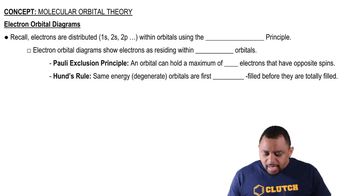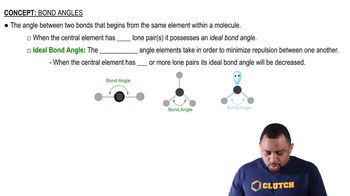Draw a picture that shows all three 2p orbitals on one atom and all three 2p orbitals on another atom. (a) Imagine the atoms coming close together to bond. How many σ bonds can the two sets of 2p orbitals make with each other?
Ch.9 - Molecular Geometry and Bonding Theories

Brown14th EditionChemistry: The Central ScienceISBN: 9780134414232Not the one you use?Change textbook
Chapter 9, Problem 74a
Indicate whether each statement is true or false. (a) p orbitals can only make σ or σ* molecular orbitals.
 Verified step by step guidance
Verified step by step guidance1
Understand the types of molecular orbitals: Molecular orbitals are formed by the linear combination of atomic orbitals. The two main types are sigma (σ) and pi (π) orbitals.
Review the characteristics of p orbitals: p orbitals have a dumbbell shape and can overlap in different ways to form molecular orbitals.
Consider the formation of σ molecular orbitals: When two p orbitals overlap end-to-end (along the internuclear axis), they form a σ molecular orbital.
Consider the formation of π molecular orbitals: When two p orbitals overlap side-by-side (perpendicular to the internuclear axis), they form a π molecular orbital.
Evaluate the statement: Since p orbitals can form both σ and π molecular orbitals, the statement that p orbitals can only make σ or σ* molecular orbitals is false.

Verified video answer for a similar problem:
This video solution was recommended by our tutors as helpful for the problem above.
Video duration:
46sWas this helpful?
Key Concepts
Here are the essential concepts you must grasp in order to answer the question correctly.
p Orbitals
P orbitals are one of the types of atomic orbitals that have a dumbbell shape and are oriented along the x, y, and z axes. Each p orbital can hold a maximum of two electrons and is involved in bonding through the overlap with other orbitals. Understanding the characteristics of p orbitals is essential for predicting how they participate in molecular bonding.
Recommended video:
Guided course

Electron Orbital Diagrams
Molecular Orbitals
Molecular orbitals are formed when atomic orbitals combine during the bonding process. They can be classified as bonding (σ) or antibonding (σ*), depending on whether the overlap of atomic orbitals leads to a lower or higher energy state, respectively. The formation of these orbitals is crucial for understanding the stability and reactivity of molecules.
Recommended video:
Guided course

Molecular Orbital Theory
σ and σ* Bonding
σ (sigma) bonds are formed by the head-on overlap of orbitals, allowing for strong bonding between atoms, while σ* (sigma star) represents the antibonding counterpart, which destabilizes the bond. P orbitals can participate in the formation of both σ and π bonds, but the statement in the question incorrectly limits their role to only σ and σ* molecular orbitals.
Recommended video:
Guided course

Bond Angles
Related Practice
Textbook Question
Textbook Question
Draw a picture that shows all three 2p orbitals on one atom and all three 2p orbitals on another atom. (b) How many p bonds can the two sets of 2p orbitals make with each other?
Textbook Question
Draw a picture that shows all three 2p orbitals on one atom and all three 2p orbitals on another atom. (c) How many antibonding orbitals, and of what type can be made from the two sets of 2p orbitals?
Textbook Question
Indicate whether each statement is true or false. (b) The probability is always 0% for finding an electron in an antibonding orbital.
Textbook Question
Indicate whether each statement is true or false. (c) Molecules containing electrons that occupy antibonding orbitals must be unstable.
Textbook Question
Indicate whether each statement is true or false. (d) Electrons cannot occupy a nonbonding orbital.
